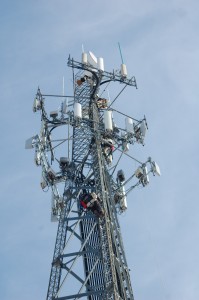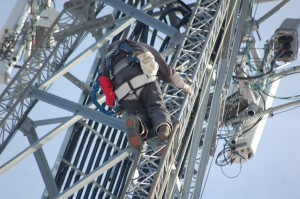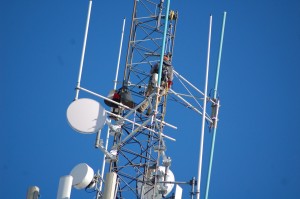WESTFIELD—The citywide radio improvement plan is moving toward the finish line, which city officials say will provide additional safety and improved communications for city departments.
The plan, which began following a 2015 City Council approval of a $2.15 million bond for the project, is expected to improve communication between a number of city departments. The project is being done in two phases, with phase one currently going on. After the first phase is finished, the new radio system will be operational.

A worker from Goosetown Communications from Congers, New York, is perched in a Westfield radio tower undergoing improvements. (Photo credit: Peter Cowles)
“It’s a replacement of all the radios in public safety, [department of public works], health department, emergency management and the [Barnes Regional] Airport,” Lenore Bernashe, information technology manager for the city of Westfield, said. “This would allow everyone to communicate together.”
Mayor Brian Sullivan, who has been a proponent of the upgrade, said in a message that he is pleased with what this can provide for the city.
“I’m looking forward to completing a multi-year project that is going to bring service and redundancy to our public safety department communications,” Sullivan wrote.
The first phase will be focused on four towers currently used, which are located near the Granville water treatment plant in Granville, at Westfield Gas and Electric off of Turnpike Industrial Road, at the Westfield technology center on Apremont Way and at the Westfield Police station on Washington Street.
Phase two’s locations were not revealed, however.
Both phases of the project revolve around replacing and improving technology that is on or around the multiple towers in the city. The towers provide radio frequencies for the many departments in Westfield, but Bernashe said that it is currently cumbersome and unreliable for different departments to communicate with one another at times.

A worker from Goosetown Communications in Congers, New York, climbs down a Westfield radio tower while tethered with a bungee cord. (Photo credit: Peter Cowles)
For example, in a 2015 article from The Westfield News about the project, it was said that in the 2011 tornado and October snow storm emergency personnel had to rely on their personal cell phones at times to communicate with each other, rather than the radios that were provided from the city.
Also, Bernashe said that the new system would reduce the amount of “dead spots” in the current radio system. Dead spots are points within a radio frequency area where radio units are unable to communicate with each other. These situations can not only cause frustration with users but can also put public safety personnel at risk if they are unable to communicate back with their dispatching center.
The upgraded system will also create a fully-digital radio interface for all departments that utilize radio communications. According to Bernashe, the Westfield Fire Department currently utilizes what is known as a fully analog radio system, while Westfield Police use a mixed digital and analog system, and the rest use fully digital. According to Bernashe, Westfield Fire Department has not yet made the switch due to local communities’ communications systems not being upgraded and that the department both requests and assists other community departments from time to time.
The benefits of going digital over analog is that digital systems have a greater distance that they can cover, they have less of a potential for interference and they allow for greater amounts of different channels of communication. Analog, which consists of the familiar bandwidths UHF and VHF, operate similar to how an FM radio transmitter may work, which can be easily interfered with and has a smaller range.

A worker from Goosetown Communications from Congers, New York, works high above Westfield on one of the radio towers. (Photo credit: Peter Cowles)
Additionally—and this was an issue when Springfield Police Department went fully digital for their radio system—the digital frequencies allow the feeds to be encrypted, which means that scanners not set up with the coding cannot listen in. This could be viewed as secretive, especially those who are scanner hobbyists or media who rely on scanner traffic to know the goings on of the city. However, Bernashe said that only certain police channels would be encrypted, meaning that the rest of the police channels can be heard over up-to-date scanner systems.
Regarding completion of the project, Bernashe said that phase one would be completed “in the next month or two,” but no firm date was set.

